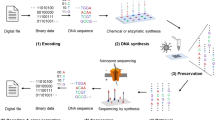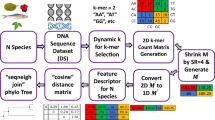Abstract
We describe how deletion-correcting codes may be enhanced to yield codes with double-strand DNA-sequence codewords. This enhancement involves abstractions of the pertinent aspects of DNA; it nevertheless ensures specificity of binding for all pairs of single strands derived from its codewords—the key desideratum of DNA codes– i.e. with binding feasible only between reverse complementary strands. We defer discussing the combinatorial-optimization superincumbencies of code construction. Generalization of deletion similarity to an optimal sequence-alignment score could readily effect advantageous improvements (Kaderali, Master's Thesis, Informatics, U. Köln, 2001) but would render the combinatorics opaque. We mention motivating applications of DNA codes.
Similar content being viewed by others
References
L.M. Adleman, “Molecular computation of solutions to combinatorial problems,” Science, vol. 266, pp. 1021–1024, 1994.
G.I. Bell and D.C. Torney, “Repetitive DNA sequences: Some considerations for simple sequence repeats,” Computers and Chemistry. vol. 17, pp. 185–190, 1993.
K.J. Breslauer, R. Frank, H. Blocker, and L.A. Markey, “Predicting Duplex DNA Stability from the base sequence,” PNAS USA, vol. 83, pp. 3746–3750, 1986.
H. Cai, P.S. White, D.C. Torney, A. Deshpande, Z. Wang, B. Marrone, and J.P. Nolan, “Flow cytometry-based minisequencing: A new platform for high throughput single nucleotide polymorphism scoring,” Genomics, vol. 66, pp. 135–143, 2000.
C.J. Colbourn and J.H. Dinitz, The CRC Handbook of Combinatorial Designs. CRC Press: Boca Raton, 1996.
A.G. D'yachkov and D.C. Torney, “On similarity codes,” IEEE Trans. on Information Theory, vol. 46, pp. 1558–1564, 2000.
A.G. D'yachkov, D.C. Torney, P.A. Vilenkin, and P.S. White, “Reverse—Complement similarity codes,” IEEE Trans. on Information Theory, submitted.
P.L. Erdös, P. Ligeti, P. Sziklai, and D. C. Torney, “Subwords in reverse complement order,” in preparation.
P.L. Erdös, D.C. Torney, and P. Sziklai, “A finite word poset,” Elec. J. of Combinatorics, vol. 8, 2001.
H.D.L. Hollman, “A relation between Levenshtein-type distances and insertion and deletion correcting capabilities of codes,” IEEE Trans. on Information Theory, vol. 39, pp. 1424–1427, 1993.
D.L. Johnson, Presentation of Groups, 2nd edition. London Mathematical Society Student Texts, Cambridge University Press: Cambridge, vol. 15, 1997.
L. Kaderali, “Selecting target specific probes for DNA arrays,” Master's Thesis, Informatics, U. Köln, 2001.
L. Kaderali, A. Deshpande, J.P. Nolan, and P.S. White, “Primer-design for multiplexed genotyping,” Nucleic Acids Research, vol. 31, pp. 1796–1802, 2003.
V.I. Levenshtein, “Binary codes capable of correcting deletions, insertions, and reversals,” J. Soviet Phys. Doklady, vol. 10, pp. 707–710, 1966.
A. Marathe, A.E. Condon, and R.M. Corn, “On combinatorial DNA design,” J. Comp. Biol., vol. 8, pp. 201–219, 2001.
S.B. Needleman and C.D. Wunsch, “A general method applicable to the search for similarities in the amino-acid sequences of two proteins,” J. Mol. Biol., vol. 48, pp. 443–453, 1970.
Q. Ouyang, P.D. Kaplan, S. Liu, and A. Libchaber, “DNA solution of the maximal clique problem,” Science, vol. 278, pp. 446–449, 1997.
V.V. Rykov, A.J. Macula, C.M. Korzelius, D.C. Englehart, D.C. Torney, and P.S. White, “DNA sequences constructed on the basis of quaternary cyclic codes,” in Proceedings of the 4thWorld Multiconference on Systematics, Cybernetics, and Informatics, SCI 2000/ISAS 2000, Orlando, Florida, July 2000.
K. Sakamoto, H. Gouzu, K. Komiya, D. Kiga, S. Yokoyama, T. Yokomori, and M. Hagiya, “Molecular computation by DNA hairpin formation,” Science, vol. 288, pp. 1223–1226, 2000.
N. Shalaby, J.M.Wang, and J.X. Yin, “Existence of perfect 4-deletion-correcting-codes with length six,” Designs, Codes and Cryptography, vol. 27, pp. 145–156, 2002.
T.F. Smith and M.S. Waterman, “Identification of common molecular subsequences,” J. Mol. Biol., vol. 147, pp. 195–197, 1981.
J.D. Ullman, “On the capabilities of codes to correct synchronization errors,” IEEE IT, vol. 13, pp. 95–105, 1967.
R.R. Varšamov and G.M. Tenengol'ts, “One-asymmetrical-error correction codes (in Russian),” Avtomatika I Telemekhanika, vol. 26, pp. 288–292, 1965.
J. Yin, “A combinatorial construction for perfect deletion-correcting codes,” Designs, Codes, and Cryptography, vol. 26, pp. 99–110, 2001.
Author information
Authors and Affiliations
Rights and permissions
About this article
Cite this article
D'yachkov, A.G., Erdös, P.L., Macula, A.J. et al. Exordium for DNA Codes. Journal of Combinatorial Optimization 7, 369–379 (2003). https://doi.org/10.1023/B:JOCO.0000017385.39168.0d
Issue Date:
DOI: https://doi.org/10.1023/B:JOCO.0000017385.39168.0d




